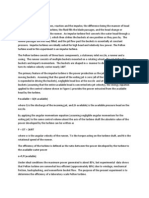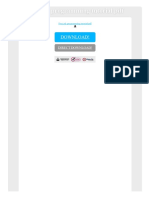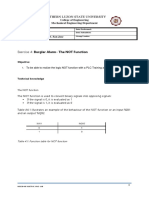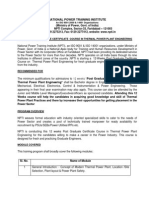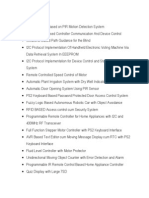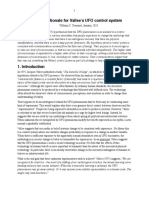Liquid Level Control System V2
Uploaded by
Shisanu SenLiquid Level Control System V2
Uploaded by
Shisanu SenNATIONAL INSTITUTE OF TECHNOLOGY, DURGAPUR
DEPARTMENT OF ELECTRICAL ENGINEERING
Experiment No. 1.
Objective: Design and Implementation of liquid level control System.
Introduction
The industrial application of liquid level control is tremendous especially in process industries.
Various applications where liquid level control is crucial are boiler drums level control in power plant,
liquid level control in evaporator system, food processing, dairy and beverages industry, chemical
production, processing and storage plants, Petroleum and Petro chemical Industry etc.
The system under investigation is a laboratory scale model setup of overhead tank liquid level
control system. The main objective is to maintain a constant liquid level independent of the output flow
rate of liquid from the tank by controlling the inflow rate of liquid into the tank. Another application where
liquid level control system plays an important role is to control flow, which occur due to gravitational
force.
Description of the Level Control System
The liquid level control system consists of two water tanks as shown in figure 1, each are mounted
on a platform such that lower one sump tank (reservoir) which stores the water and overhead tank in which
water level is to be controlled. Two water tanks vertically positioned in such a manner so that outflow
from the top tank (overhead) serves as inflow for the lower tank (sump) due to gravitational force. The
water level in the overhead tank is measured by an ultrasonic non-contact type liquid level sensor and
controlled by controlling the inflow rate into the overhead tank with the help of a control valve. From the
overhead tank, water drains out due to gravitational force, so depending upon the potential head of the
water in the overhead tank its flow through the output valve will vary. When level in the overhead tank is
high then water drains through outlet with high pressure and velocity and vice versa otherwise. A pump
is used to deliver the water from sump tank to overhead tank. Thus to maintain a constant level in the
overhead tank, inlet flow must be controlled in such a manner that it becomes equal to outflow rate at the
desired set value of the liquid level. A photograph of the actual setup is shown in figure 2. The details of
the different components are given in ANNEXURE I.
ADVANCED ELECTRICAL ENGINEERING LABORATORY
Experiment:
A. Study the program to read the current liquid level from the Analog Input (AI) port (Tag. RAW USTX
SIGNL) and user given remote set point (Tag. OT SCADA SP). Use a PID controller block to generate
a control signal accordingly and then send the output to the Analog Output (AO) port (Tag. OT CV
Out).
In addition to this continuous control, turn off the pump if any one of these situations occurs.
i) Water level in Sump tank is below the lower level.
ii) Water level in the Overhead tank is above upper level limit.
Read the corresponding digital inputs from DI ports (Tag. GT USLSW IND and OT USLSW IND)
generate the logic with OR function-block and send the output decision to the pump through DO port
(Tag. PUMP SW RESET).
B. Run the SCADA program, set the PID controller in P control mode with P=1, calculate settling time,
rise time, delay time etc. for three different set point values.
C. Now use different P, I and D values and observe the control action, collect three set of ridings for three
different set point values and record the parameters according to Table I.
Different set of Controller parameter Record
readings P I D Set Point Liquid Level Controller Output
Exp. 1
Set Point 1 Exp. 2
Exp. 3
Exp. 1
Set Point 2 Exp. 2
Exp. 3
Exp. 1
Set Point 3 Exp. 2
Exp. 3
ADVANCED ELECTRICAL ENGINEERING LABORATORY
D. Simulate the mathematical model (see ANNEXURE-II) of the system in MATLAB/SIMULINK
observe the response and tune model parameters to approximate the response of the simulated system
closer to experimental response.
i) Obtain the step and impulse response of the process transfer function.
ii) Find the Root locus, Nyquist and Bode plot and also find gain and phase margins.
iii) Apply different PID tuning techniques to estimate the proper P, I and D values.
iv) Suggest an optimum P, I and D values for the controller.
v) Simulate the total system along with the controller with optimum P, I and D values.
Report the followings in next experiment day (One Group one Copy):
I. Provide the results obtained from B, C and D.
II. Describe in detail with suitable figures
III. Experimental Procedure (with screen snap shots)
Electrical Actuator and Control valve (Type: as in experiment).
Ultrasonic Level Sensor and Ultrasonic contact type level switch
Solenoid Valve
DCS (HC 900 Hardware Details)
DCS (SCADA Software Details)
ANNEXURE-I
Description of the different components
Sump Tank: This is the tank in which water is collected from overhead tank and is stored. A pump is
used to pump the water into the overhead tank from this tank. A level switch is placed into this tank to
sense lower level of the liquid. This switch can be used as protection for the pump, i.e. when water level
into the sump tank is low, and then pump will not start to avoid any dry run.
Water pump: The delivery pump is used to pump the water from sump tank to overhead tank, a control
valve is placed in the delivery side of the pump to control the inflow rate to the tank, a bypass line is
placed before the control valve to protect pump in overload condition i.e. when control valve will be in
100% close condition. The pump is driven by the single phase induction motor, rated 220V, 50 Hz, 2.5
Amps and 3000 rpm.
Overhead tank: The liquid level in the overhead tank needs to be controlled with the help of PID control
action. The liquid level is measured with the help of an ultrasonic level sensor placed at the top of the
tank. A level switch is also placed in the top of the overhead tank to sense high liquid level, this is used to
protect overflow of water from the overhead tank.
Control Valve: The function of the control valve is to control the flow through the pipe; there is a
electrically actuated control valve placed in the inflow line of the overhead tank.
A cross section view of a control valve is shown in Figure 2. The valve plug is movable and can regulate
the flow rate by varying the effective flow area.
ADVANCED ELECTRICAL ENGINEERING LABORATORY
Figure 2. Cross section view of single seat two port globe valve.
The movement or position of the valve plug is controlled by an electrical actuator placed at the top of the
valve. The internal diagram of an electrical actuator is shown in Figure 3.
Figure 3. Internal diagram of an electrical actuator
A positioning circuit may is also included in the actuator, which accepts an analogue control signal
(typically 0-10 V or 4-20 mA) from the controller. The actuator then interprets this control signal, as the
valve position between the limit switches. The actuator has a position sensor (usually a potentiometer),
which feeds the actual valve position back to the positioning circuit. In this way the actuator can be
positioned along its stroke in proportion to the control signal. A schematic of the modulating actuator is
shown in Figure 4.
ADVANCED ELECTRICAL ENGINEERING LABORATORY
Figure 4. Functional diagram of an electrical actuator
Level sensors: Ultrasonic level sensor is used and which is mounted on the top of the overhead tank at a
certain height so that it can measure the tank water level by transmitting and receiving the ultrasonic wave.
Ultrasonic sensors use sound waves to measure distance. A sensor would normally be mounted at the top
of a tank and direct a sound wave down towards the surface of the product. When the sound wave hits the
product it is reflected and returned to the sensor. The greater the distance between the sensor and the
product, the longer it will take for the sound wave to travel down and back up again. The sensors calculate
this time interval and give a signal proportional to the distance. They also compensate for the changes in
the speed of sound due to changes in temperature. A scheme for measurement of level using ultrasound is
shown in Figure 5.
The ultrasonic transmitter generates analog output (4-20mA) according to the water level in the tank, 4
mA when water level at lowest position and 20 mA when it is at maximum position and in between values
for in between level.
Figure 5. Measurement of level using ultrasound
Outflow from Overhead tank: A pipe along with the solenoid valve is connected at the bottom of the
overhead tank and at the top of the sump tank, which allows flowing water from overhead tank to sump
tank, occur due to gravitational force. This flow can be stopped by operating the solenoid valve.
ADVANCED ELECTRICAL ENGINEERING LABORATORY
Solenoid valve: A solenoid valve is an electro-mechanical device that when energized or de-energized
either opens or closes valve opening. A functional diagram of a Solenoid Valve is shown in Figure 6.
Figure 6. Functional diagram of a solenoid valve
Level Switch: A level switch is a device which can sense whether the water level is above or below to
certain value. Thus it gives a signal (ON/OFF), i.e. in binary. Contact ultrasonic level switches use ceramic
discs called piezoelectric crystals to transmit and receive ultrasonic energy. A transmit crystal (T) is on
one side of a transducer gap and a receive crystal (R) is on the opposite side. The side-gap must be (as
shown in Figure 7.) completely filled with fluid before liquid level is sensed and the switches goes to ON
position.
Figure 7. Ultrasonic contact type level switch
Controller: A controller is provided for controlling the water level of the tank, the information about the
current water level is sensed by the ultrasonic sensor and transmitted to the analog input (4-20mA) of the
controller, the controller then send a corrective signal (4-20mA) on the basis of the user given desired
value (set value) of the liquid level to the final control element 9electrical actuator). The final control
element then controls the flow rate by opening and closing the valve to control the liquid level. The
switches provide a digital output (ON/OFF) signal which goes to Digital input of the controller and the
Solenoid valve which also accept digital signal is connected to the Digital output of the controller. The
ADVANCED ELECTRICAL ENGINEERING LABORATORY
use of these switches and solenoid valve is to avoid unusual events and for safety purpose. Different
component of a controller is shown in Figure 8.
Figure 8. Controller (HC900)
For the control action a Distributed Control System (DCS) is provided for all the loops in the laboratory.
Various sensors/transmitters are connected to the Analog/Digital Input card of the DCS and all the
actuators, pumps, compressor etc. are connected to the Analog/Digital output card of the DCS. The
controller communicates with users and is programmed with the help of SCADA (Supervisory Control
and Data Acquisition System) software. The program to control the liquid level is given in Figure 9, and
the SCADA, HMI (Human Machine Interface) is shown in Figure 10.
Figure 9. SCADA Program for liquid level control.
ADVANCED ELECTRICAL ENGINEERING LABORATORY
Figure 10. SCADA HMI Interface
Description of different functional blocks:
1) Analog input:
Function:
Reads value of an Analog Input from a specified real I/O address. Convert analog input value to
corresponding output (OUT) in engineering units based on the necessary scaling and conversions
performed.
Input:
Analog value from specified I/O address.
DIS = disable the AI channel
Output:
OUT= Analog input value in engineering units.
WARN= Warning input indication-sensor failure possibility.
FAIL= Digital status of channel.
Digital low (0)= OK
2) PID
ADVANCED ELECTRICAL ENGINEERING LABORATORY
The PID label stands for Proportional, Integral, and Derivative (3-mode) control action. This block is part
of the Loop Blocks category.
Function:
Provides Proportional (P), Integral (I) and Derivative (D), 3-mode control action based on the deviation
or error signal created by the difference between the set point (SP) and the Process Variable analog input
value (PV).It provides two digital output signals for alarms based on configured parameters. The PID
function block provides for Feed forward, Cascade, and Ratio control. Automatic tuning with Fuzzy Logic
Overshoot Suppression can be configured.
Inputs:
PV = Process Variable Analog Input value in Engineering Units to be controlled.
RSP= Remote Set point Analog Input value in Engineering Units or Percent to provide external set
point.
FFV = Feed forward value in percent. The Feed forward value is multiplied by the Feed forward Gain,
then directly summed into the output of the PID block
TRV = Output Track value in Percentage (PID Output = TRV Input when TRC = ON.
TRC = Output Track Command [ON, OFF (On -Enables TRV.) (Mode = Local Override)
BIAS = Remote Bias value for Ratio PID
SWI = Switch Inputs (from SWO on LPSW function block).
MDRQI = External Mode request (typically connected to the MDRQO output of a MDSW function
block that encoded discrete switch inputs).
BCI = Back Calculation Input (for blocks used as Cascade Primary).
Output:
OUT = Control Output.
WSP = Working Setpoint in Engineering Units for monitoring.
AL1 = Alarm 1 - Digital Signal.
AL2 = Alarm 2 - Digital Signal.
DIRECT = Direct Acting control (ON = Direct, OFF = Reverse Acting).
ATI = Auto tune Indicator (ON = Auto tune in Progress).
MODE = Loop mode status (typically connected to the Mode Flags block for encoding).
BCO= Back Calculation Output (for blocks used as Cascade Secondary)
3) Analog output:
Function:
ADVANCED ELECTRICAL ENGINEERING LABORATORY
Range High and Range Low are used to specify the Engineering Unit values for 100% and 0% of this
blocks input span. For reverse outputs, Range High may be set to a value less than Range Low. The
output range high and range low values (0-20 max) set the milliamp output values that correspond to
the 0 to 100% span limits of the inputs.
Input:
IN = Analog value
Output:
OUT = Converted value sent to specified real I/O address (mA).
FAIL = Failed Output indication - Module Error.
4) Compare:
Function:
Compares value of X input to value of Y input and turns ON one of three outputs based on this
comparison.
If X input is greater than Y input, then: XGY = ON.
If X input equals Y input, then: XEY = ON.
If X input is less than Y input, then: XLY = ON.
Input:
X = First analog value.
Y = Second analog value
Output:
XGY = Digital signal state based on calculation.
XEY = Digital signal state based on calculation.
XLY = Digital signal state based on calculation
5) Discrete output:
Function:
Provides a digital status from the algorithms and functions to a physical logic output.
The output status may be inverted.
Input:
X = Input Status Signal.
ADVANCED ELECTRICAL ENGINEERING LABORATORY
Output:
FAIL = Failed Input indication - Module error.
OUT = Physical Output Value.
6) Input OR
The 4OR label stands for the OR(4 inputs) boolean logic function. This block is a part of the logic category.
Function:
Turns digital output(OUT) OFF when input X1 to X4 are OFF thus,
When input X1 or X2 or X3 or X4 is ON then OUT=ON
If all input are off then OUT=OFF
Input:
X1=First digital signal.
X2=Second digital signal.
X3=Third digital signal.
X4=fourth digital signal.
Output:
OUT= digital signal controlled by the status of the input signal.
ANNEXURE-II
Mathematical model of the process
The system is modelled as a first-order system. The tank acts as a fluid capacitor where fluid enters
the tank (behaving as charged particles entering a capacitor) and leaves the tank. According to mass
balance relation between the incoming fluid and outgoing fluid can be written as:
{rate of accumulation mass in the system}= {rate of mass entering in the system}-
{rate of mass leaving in the system}
Q=Qin +Qout
where Qin is the flow rate of water coming into the tank, Q the net rate of water storage in the tank, and
Qout is the flow rate of water going out from the tank. If A is the cross-sectional area of the tank, and h is
the height of water inside the tank at any instant, Equation can be written as:
= +
where is the rate of change of height of water inside the tank.
The net flow rate (Qout) of water coming out of the tank depends on the discharge coefficient of the tank,
the height of the liquid at any instant inside the tank (h), the gravitational constant (g), and the area of the
tank outlet (a),and can be expressed as:
= (2)
ADVANCED ELECTRICAL ENGINEERING LABORATORY
where Cd is the discharge coefficient of the tank outlet, a is the area of the tank outlet, and g
is the gravitational constant (9.8m/s2).
From the above equations we obtain:
= + (2)
As we can see from the flow equation, it is a nonlinear relationship between the inflow rate (Qin) and the
height of the water inside the tank (h).This equation can be linearized for small perturbations about an
operating point.
When the input flow rate (Qin) becomes constant i.e. water comes at a constant rate, the height of the
water level in the tank also stays at certain set point. Out flow depend on the height only, if for steady Qin
height changes the Qout also change as follows:
Qout = Q0
And the height of the water h becomes a constant value h0, and we can write as:
0 = (20)
If we now consider a small perturbation (Qin) in input flow rate around the steady-state value Qo, we
obtain.
Qin = Qin Q0
And, as a result, the fluid level h will be perturbed around the steady-state value h0 by
h = h0 h
Now, substituting above equations in to flow equation we obtain:
This Equation can be linearized by using the Taylor series and all terms are neglected except the first term.
From Taylor series as:
Considering only the first term,
or
Now linearizing equation becomes:
Equation using above Equation, we obtain
Taking the Laplace transform of above Equation, we obtain the transfer function of the tank for small
perturbations about the steady-state value as a first-order system:
ADVANCED ELECTRICAL ENGINEERING LABORATORY
The pump, level sensor, and the power amplifier are simple units and can be approximated to have just
proportional gains and no system dynamics. The inputoutput relations of these units can be written as
follows:
For the pump,
Qo = KpVp;
For control valve
Vc = KvU (U = controller signal).
For delay in control valve the transfer function become
Gc(s) = +1 = Kv
for the level sensor,
Vl = Kl h;
Here Qo is the pump flow rate, Vp the voltage applied to the pump, Vl the level sensor output voltage and
Kp, Kl, Kv are constants.
So the block diagram of the level control system can be obtained as shown in Figure below:
Fig.4 block diagram of level control system
ADVANCED ELECTRICAL ENGINEERING LABORATORY
Figure 10. Model diagram of level control process
ADVANCED ELECTRICAL ENGINEERING LABORATORY
You might also like
- Exercise 13: Conveyor Belt: 1: Problem DescriptionNo ratings yetExercise 13: Conveyor Belt: 1: Problem Description10 pages
- Lab Name: Demonstration and Operation of 5KW Steam Power PlantNo ratings yetLab Name: Demonstration and Operation of 5KW Steam Power Plant14 pages
- Electropneumatic and Hydraulic DNT241: Experiment No. 4No ratings yetElectropneumatic and Hydraulic DNT241: Experiment No. 47 pages
- Performance Analysis of Domestic RefrigeratorNo ratings yetPerformance Analysis of Domestic Refrigerator10 pages
- Experiment 04: Performance Test of A Radial BlowerNo ratings yetExperiment 04: Performance Test of A Radial Blower2 pages
- Assignment 7 - Fluidsim Pneumatics - Group 2No ratings yetAssignment 7 - Fluidsim Pneumatics - Group 210 pages
- Closed Loop Response of Temperature Control SystemNo ratings yetClosed Loop Response of Temperature Control System6 pages
- ME 461 Control Engineering: Semester: July 2017No ratings yetME 461 Control Engineering: Semester: July 201732 pages
- Southern Luzon State University: College of Engineering Mechanical Engineering DepartmentNo ratings yetSouthern Luzon State University: College of Engineering Mechanical Engineering Department8 pages
- Engineering Economy 1 (MNG 151) ديزوبأ سابع ىنسح / دNo ratings yetEngineering Economy 1 (MNG 151) ديزوبأ سابع ىنسح / د45 pages
- Modeling and Control of An Air Levitation Ball and Pipe Laboratory SetupNo ratings yetModeling and Control of An Air Levitation Ball and Pipe Laboratory Setup6 pages
- Fluid Mechanics Lab Instructor Manual Final100% (1)Fluid Mechanics Lab Instructor Manual Final138 pages
- 6.5 Simple Vapor Compression Refrigeration System:: CompresorNo ratings yet6.5 Simple Vapor Compression Refrigeration System:: Compresor8 pages
- ERT 321 Process Control & Dynamics: Feedback ControllersNo ratings yetERT 321 Process Control & Dynamics: Feedback Controllers34 pages
- Tensile Test: Faculty of Mechanical EngineeringNo ratings yetTensile Test: Faculty of Mechanical Engineering85 pages
- Refrigeration Laboratory Unit ExperimentNo ratings yetRefrigeration Laboratory Unit Experiment9 pages
- Lecture Note Chapter 11 PID Controller Design Tuning and Troubleshooting 2016No ratings yetLecture Note Chapter 11 PID Controller Design Tuning and Troubleshooting 201661 pages
- Experiment No.5 Forced Convection: Heat Transfer Laboratory (MECH3123)No ratings yetExperiment No.5 Forced Convection: Heat Transfer Laboratory (MECH3123)6 pages
- 07-Squirrel Cage Induction Motor-Experiments ManualNo ratings yet07-Squirrel Cage Induction Motor-Experiments Manual25 pages
- LECTURE 6 Logic Operation in Electro Pneumatic PDFNo ratings yetLECTURE 6 Logic Operation in Electro Pneumatic PDF31 pages
- Control N Instrumentation Lab ExperimentsNo ratings yetControl N Instrumentation Lab Experiments9 pages
- @2 - Mathematical Modeling of Control System ?No ratings yet@2 - Mathematical Modeling of Control System ?52 pages
- Fdocuments - in 51634963 Orifice Discharge Lab ReportNo ratings yetFdocuments - in 51634963 Orifice Discharge Lab Report2 pages
- Complex Engineering Problem: Submitted To Sir Umer Hamid Submitted by Hassan (04) Danish (14) SumamaNo ratings yetComplex Engineering Problem: Submitted To Sir Umer Hamid Submitted by Hassan (04) Danish (14) Sumama14 pages
- On-Off Control System Characteristic: Oleh: Rizqiya W. Saputra, M.TNo ratings yetOn-Off Control System Characteristic: Oleh: Rizqiya W. Saputra, M.T10 pages
- Automatic Liquid Level Control of Tank SystemNo ratings yetAutomatic Liquid Level Control of Tank System9 pages
- Electrostatic Precipitator Knowledge Base PDF100% (1)Electrostatic Precipitator Knowledge Base PDF9 pages
- 12 Weeks Post Graduate Certificate Course in Thermal Power Plant EngineeringNo ratings yet12 Weeks Post Graduate Certificate Course in Thermal Power Plant Engineering6 pages
- Control Systems (CS) : Lecture-6 Steady State ErrorNo ratings yetControl Systems (CS) : Lecture-6 Steady State Error20 pages
- A Specific Rationale For Vallee's UFO Control System100% (1)A Specific Rationale For Vallee's UFO Control System5 pages
- Finn Haugen - Basic Dynamics - CH 010 - Tuning PID - Skogestad's Method - Integrator Processes - CA6B81DDd01No ratings yetFinn Haugen - Basic Dynamics - CH 010 - Tuning PID - Skogestad's Method - Integrator Processes - CA6B81DDd0127 pages
- Installation Manual Series D 1FH: Proportional DC Valve100% (1)Installation Manual Series D 1FH: Proportional DC Valve20 pages
- Process Control Instrumentations Engineering CollegeNo ratings yetProcess Control Instrumentations Engineering College92 pages
- Zin Maung Cho - IMPLEMENTATION OF AUTONOMOUS GROUND VEHICLE (AGV)No ratings yetZin Maung Cho - IMPLEMENTATION OF AUTONOMOUS GROUND VEHICLE (AGV)7 pages
- BUILDING MANAGEMENT SYSTEM BMS - Pamela David100% (1)BUILDING MANAGEMENT SYSTEM BMS - Pamela David66 pages
- Microprocessor Based Digital PID Controller For Speed Control of D.C. Motor100% (1)Microprocessor Based Digital PID Controller For Speed Control of D.C. Motor6 pages
- Experiment: AIM: Study D.C Position Control SystemNo ratings yetExperiment: AIM: Study D.C Position Control System23 pages
- Tce5002 Introduction To PDC, Modelling Simulation & ControlNo ratings yetTce5002 Introduction To PDC, Modelling Simulation & Control15 pages
- IntroCtrlSys - Final Exam - Fall Semester - 1516 PDFNo ratings yetIntroCtrlSys - Final Exam - Fall Semester - 1516 PDF1 page
- Datasheet GEF GPD Temp Control Valve 1111 Rev3No ratings yetDatasheet GEF GPD Temp Control Valve 1111 Rev319 pages
- Manual de Operacion y Mantenimiento Compresor Sullair Ls25 S100% (3)Manual de Operacion y Mantenimiento Compresor Sullair Ls25 S176 pages
- Exercise 13: Conveyor Belt: 1: Problem DescriptionExercise 13: Conveyor Belt: 1: Problem Description
- Lab Name: Demonstration and Operation of 5KW Steam Power PlantLab Name: Demonstration and Operation of 5KW Steam Power Plant
- Electropneumatic and Hydraulic DNT241: Experiment No. 4Electropneumatic and Hydraulic DNT241: Experiment No. 4
- Experiment 04: Performance Test of A Radial BlowerExperiment 04: Performance Test of A Radial Blower
- Closed Loop Response of Temperature Control SystemClosed Loop Response of Temperature Control System
- Southern Luzon State University: College of Engineering Mechanical Engineering DepartmentSouthern Luzon State University: College of Engineering Mechanical Engineering Department
- Engineering Economy 1 (MNG 151) ديزوبأ سابع ىنسح / دEngineering Economy 1 (MNG 151) ديزوبأ سابع ىنسح / د
- Modeling and Control of An Air Levitation Ball and Pipe Laboratory SetupModeling and Control of An Air Levitation Ball and Pipe Laboratory Setup
- 6.5 Simple Vapor Compression Refrigeration System:: Compresor6.5 Simple Vapor Compression Refrigeration System:: Compresor
- ERT 321 Process Control & Dynamics: Feedback ControllersERT 321 Process Control & Dynamics: Feedback Controllers
- Lecture Note Chapter 11 PID Controller Design Tuning and Troubleshooting 2016Lecture Note Chapter 11 PID Controller Design Tuning and Troubleshooting 2016
- Experiment No.5 Forced Convection: Heat Transfer Laboratory (MECH3123)Experiment No.5 Forced Convection: Heat Transfer Laboratory (MECH3123)
- 07-Squirrel Cage Induction Motor-Experiments Manual07-Squirrel Cage Induction Motor-Experiments Manual
- LECTURE 6 Logic Operation in Electro Pneumatic PDFLECTURE 6 Logic Operation in Electro Pneumatic PDF
- Fdocuments - in 51634963 Orifice Discharge Lab ReportFdocuments - in 51634963 Orifice Discharge Lab Report
- Complex Engineering Problem: Submitted To Sir Umer Hamid Submitted by Hassan (04) Danish (14) SumamaComplex Engineering Problem: Submitted To Sir Umer Hamid Submitted by Hassan (04) Danish (14) Sumama
- On-Off Control System Characteristic: Oleh: Rizqiya W. Saputra, M.TOn-Off Control System Characteristic: Oleh: Rizqiya W. Saputra, M.T
- 12 Weeks Post Graduate Certificate Course in Thermal Power Plant Engineering12 Weeks Post Graduate Certificate Course in Thermal Power Plant Engineering
- Control Systems (CS) : Lecture-6 Steady State ErrorControl Systems (CS) : Lecture-6 Steady State Error
- A Specific Rationale For Vallee's UFO Control SystemA Specific Rationale For Vallee's UFO Control System
- Finn Haugen - Basic Dynamics - CH 010 - Tuning PID - Skogestad's Method - Integrator Processes - CA6B81DDd01Finn Haugen - Basic Dynamics - CH 010 - Tuning PID - Skogestad's Method - Integrator Processes - CA6B81DDd01
- Installation Manual Series D 1FH: Proportional DC ValveInstallation Manual Series D 1FH: Proportional DC Valve
- Process Control Instrumentations Engineering CollegeProcess Control Instrumentations Engineering College
- Zin Maung Cho - IMPLEMENTATION OF AUTONOMOUS GROUND VEHICLE (AGV)Zin Maung Cho - IMPLEMENTATION OF AUTONOMOUS GROUND VEHICLE (AGV)
- Microprocessor Based Digital PID Controller For Speed Control of D.C. MotorMicroprocessor Based Digital PID Controller For Speed Control of D.C. Motor
- Experiment: AIM: Study D.C Position Control SystemExperiment: AIM: Study D.C Position Control System
- Tce5002 Introduction To PDC, Modelling Simulation & ControlTce5002 Introduction To PDC, Modelling Simulation & Control
- IntroCtrlSys - Final Exam - Fall Semester - 1516 PDFIntroCtrlSys - Final Exam - Fall Semester - 1516 PDF
- Manual de Operacion y Mantenimiento Compresor Sullair Ls25 SManual de Operacion y Mantenimiento Compresor Sullair Ls25 S



